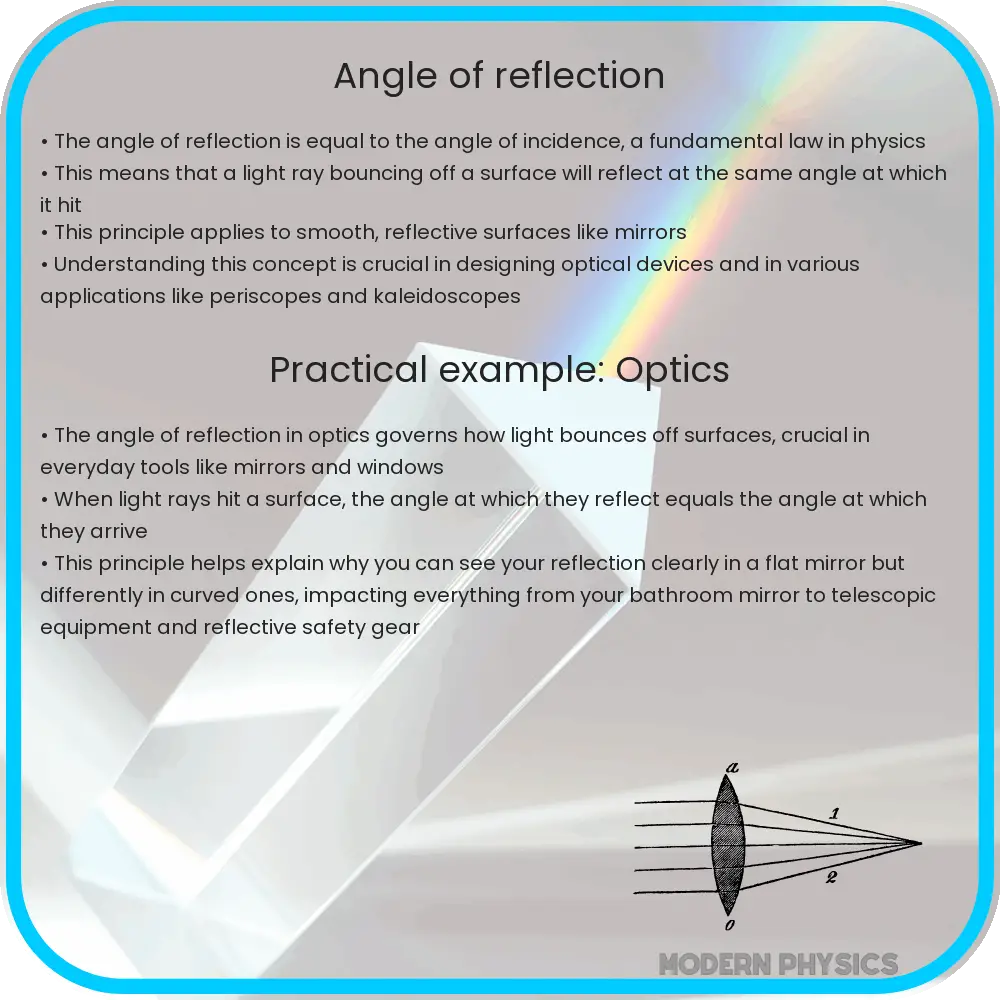Explore the fundamentals of optics with a focus on the angle of reflection, its laws, and diverse applications in technology and daily life.

Understanding the Angle of Reflection in Optics
The principle of reflection is fundamental in the field of optics, playing a pivotal role in various applications ranging from simple mirrors to sophisticated optical instruments. The angle of reflection, a key concept in this domain, is defined by the law of reflection. This law states that when a ray of light strikes a surface, the angle of reflection (the angle at which the light is reflected) is equal to the angle of incidence (the angle at which the light hits the surface). Mathematically, if θi is the angle of incidence and θr is the angle of reflection, then θi = θr.
Laws of Reflection
There are two fundamental laws of reflection:
- First Law: The incident ray, the reflected ray, and the normal (perpendicular) to the reflection surface at the point of incidence lie in the same plane.
- Second Law: The angle of incidence is equal to the angle of reflection.
Applications in Everyday Life and Technology
The principles of reflection find applications in a myriad of everyday and technological contexts:
- Mirrors: The most common use of reflection is in mirrors, where a smooth surface causes specular reflection, directing the light rays in a single direction and forming a clear image.
- Periscopes: Used in submarines and in certain types of surveillance equipment, periscopes use mirrors at specific angles to allow viewing over, around, or through an obstacle or object.
- Optical Instruments: Telescopes, microscopes, and other optical devices rely on the law of reflection for directing light to produce magnified images of distant or small objects.
- Fiber Optics: In telecommunications, fiber optics technology uses the principle of total internal reflection to transmit light signals over long distances with minimal loss.
Understanding the fundamental laws of reflection and their practical applications is crucial for advancements in optical technology and for appreciating the physics behind everyday phenomena.
Optics Fundamentals: Reflection and its Effects
In the realm of optics, understanding the angle of reflection is not only about comprehending its basic laws but also about recognizing its effects and implications. For instance, the quality of reflection depends on the surface texture. Smooth surfaces produce a sharp, clear reflection, known as specular reflection, while rough surfaces scatter light in multiple directions, resulting in diffuse reflection. This distinction is crucial in designing optical devices, architectural lighting, and even in photography and art.
Scientific and Industrial Applications
Beyond everyday gadgets and communication technology, the principles of reflection have significant scientific and industrial applications:
- Astronomy: Astronomical telescopes utilize mirrors to gather and focus light from distant celestial bodies, enabling the study of stars, planets, and galaxies.
- Solar Energy: Reflective surfaces are integral in solar panels and solar thermal power plants, where they are used to concentrate solar radiation onto a small area to generate electricity or heat.
- Measurement and Detection Systems: Devices like rangefinders and speed guns use the reflection of light, often lasers, to measure distances or speed.
- Automotive and Aviation: Reflective materials are used in vehicle headlamps, road signs, and on the bodies of airplanes for visibility and safety purposes.
Conclusion
The angle of reflection is a cornerstone concept in the study of optics, encapsulating fundamental principles that govern how light interacts with surfaces. Its applications extend far beyond the simple act of seeing oneself in a mirror, influencing fields as diverse as telecommunications, energy production, scientific research, and safety engineering. The laws of reflection not only explain a basic physical phenomenon but also provide the foundation for innovations that permeate our daily lives and industries. By understanding and harnessing the principles of reflection, humanity continues to make strides in technology and science, illuminating the path towards a more connected and efficient world.
